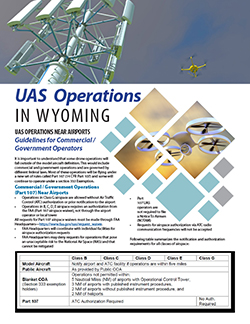- Home
- Administration
- Aeronautics
- Business with WYDOT
- Construction Projects
- Driver License and Records
- Economic Stimulus Projects (ARRA - TIGER)
- Engineering and Technical Programs
- Fuel Tax
- Highway Safety
- Human Resources
- Manuals and Publications
- News and Information
- Permits
- Planning/Projects/Research
- Titles, Plates and Registration
- Travel
- Trucking / Commercial Vehicles
- Vehicle Business Regulation
- Wyoming Highway Patrol
- Search
- Sitemap
UAS Operations Near Airports
Guidelines for Commercial/Government Operators

It is important to understand that some drone operations will fall outside of the model aircraft definition. This would include commercial and government operations and are governed by different federal laws. Most of these operations will be flying under a new set of rules called Part 107 (14 CFR Part 107) and some will continue to operate under a section 333 Exemption.
Commercial / Government Operations (Part 107) Near Airports
- Operations in Class G airspace are allowed without Air Traffic Control (ATC) authorization or prior notification to the airport.
- Operations in B, C, D, E airspace requires an authorization from the FAA (Part 107 airspace waiver), not through the airport operator or local tower.
All requests for Part 107 airspace waivers must be made through FAA Headquarters—https://www.faa.gov/uas/request_waiver.
- FAA Headquarters will coordinate with individual facilities for airspace authorization requests
- FAA Headquarters may deny requests for operations that pose an unacceptable risk to the National Air Space (NAS) and that cannot be mitigated.
- Part 107 UAS operators are not required to file a Notice To Airmen (NOTAM).
- Requests for airspace authorization via ATC radio communication frequencies will not be accepted.
The following table summarizes the notification and authorization requirements for all classes of airspace:







